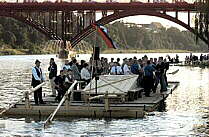 |
| Down the river on a wooden raft - a tradition that lives on |
Every summer, the banks of the Drava come to life during Maribor’s international music and tourist festival. One of the many festival stages is built in a small bay of the river so that the river becomes the backdrop against which the music is played. Another festival attraction is connected with a piece of river tradition: riding a wooden raft downstream. In the past, tree trunks were felled on the hills of Pohorje, tied together, and floated down the river all the way to Belgrade, where they were sold.
Authorities face the familiar dilemma
That tradition still holds in a way. One of the most noticeable features
of the Drava as it flows past Maribor (with a population of 200,000 Slovenia’s
second-largest city), is its calmness and almost total lack of river traffic.
That calmness has been safeguraded for the last two decades by a special
act passed by the city of Maribor, under which almost all river navigation
and traffic was prohibited. This act well demonstrates the dilemma facing
the authorities. On the one hand, the act has had a positive environmental
influence in that it has helped preserve river life and maintained the natural
and non-polluted environment for the human population. On the other hand,
it severely sets back development activity. The government has responded
by embarking on a course of measured development that preserves existing
safeguards, takes steps against possible problems, and promotes a level
of development that will not endanger the environment.
Firstly, the act's provisions have recently been modified in a way to enable
development. As a direct result of this, two water sport institutes –
one for water scooter enthusiasts and the other for rafting fans - have
emerged on the Drava’s banks.
Observing the changes alongside the river
 |
| Two water sport institutes have emerged on the Drava’s banks |
In some cases, a new development project might also seek to solve an existing
problem. An example is a recreational centre planned by the municipality
of Duplek on the outskirts of Maribor. Since the centre will lie in an area
threatened by flooding, plans have been drawn up with the participating
foreign investors to build an embankment to protect the recreational centre.
There can be no planning without proper monitoring. That is why the government
recently decided that it would be necessary to observe more accurately the
changes alongside the river. Based on these observations, long-term solutions
must be found. The task was assigned to the experts of a local firm, a successor
of the former state-run water company. The company has already developed
a programme for the economic use of the Drava water. Apart from the use
of the river water for generating hydro-electric power, these experts pointed
out some other profitable uses of the river, such as fish-farming and irrigation.
Good irrigation is important and has many complex and inter-related ramifications.
Currently, 27 small irrigation systems cover a total of 170 ha but do not
use up all of the river’s capacity. The proposed extension of the irrigation
system seeks to distribute more of the Drava’s water to the surrounding
regions for agricultural purposes.
However, man-made channelling, can also have negative impacts, as is demonstrated
by the artificial river channel built at the city borders decades ago. Through
this chaannel, water is directed towards the Zlatoli_je power station, one
of nine power stations on the Drava. The intervention has also had the negative
effect of altering the river’s flow characteristics, which resulted
in overflows in spring and autumn when the volume is high. This negative
effect has been only partially mitigated by the regulation that the artificial
channel enables. The floods, on the other hand, have occasionally caused
damage of the scale that called for compensation from the state budget.
Improving the water quality
Another important aspect of river-water management is that of pollution
control. According to measured levels of pollution, the Drava can be classified
as falling within Category 2 or Category 3, which means that the extent
of pollution is not excessive. However, the construction of a wastewater
treatment facility at Maribor is considered one of the foremost objectives
if Slovenia is to meet the rigorous ecological standards of the EU—a
pre-requisite for the country’s admittance to the EU.
Construction work for a new central wastewater cleaning facility for the
city of Maribor is currently in progress and nearing the end of the so-called
Stage One, which will enable mechanical treatment of the water. The next
stage, which will provide biological and chemical treatment, will be started
in 2003. The project is carried out by French investors, operating in Slovenia
through a joint venture which will run the facility for the next 22 years
and collect contributions to repay the investment as well as any eventual
profit.
This facility will certainly help improve the quality of the river water
and the quality of groundwater in the region, which has been decreasing
continually in the last few years. One of the major causes of groundwater
pollution lies in the intensive use of pesticides that leak into the groundwater,
such as atrazine (used as a weedkiller in cornfields). The government has
attempted to counter this threat by introducing the concept of "safeguarded
areas”, but this has had limited success. Further steps to be taken
by the government are currently being discussed. These protective measures
will be tied closely to Slovenia’s entry into the EU, and the government
is about to start implementing the EU directive that sets limit-values on
a list of dangerous substances in drinking water. These limit-values are
far lower than those currently legislated.
To round out the efforts to maintain the environment of the Drava River
in the Maribor area, the state has established a regional preserve, within
which strict environmental regulations apply. For the near future, the priority
lies in raising people’s awareness of the need to treat the environment
with more care and responsibility.